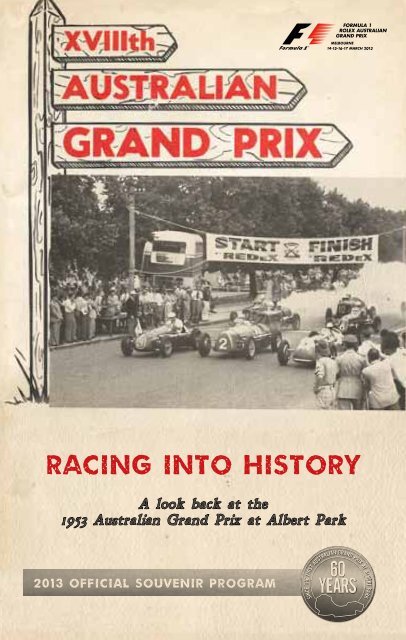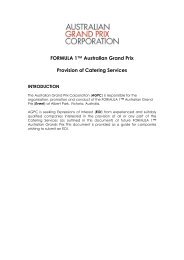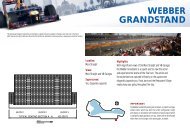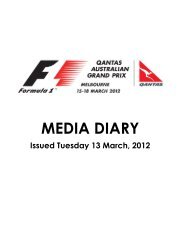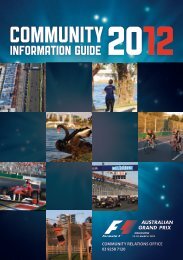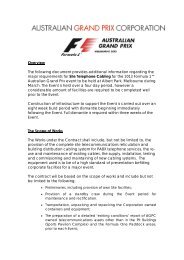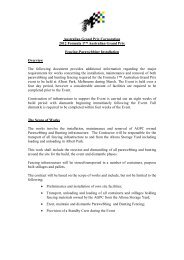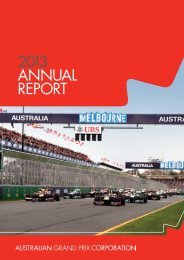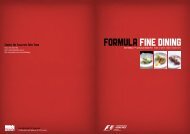RACING INTO HISTORY - Australian Grand Prix
RACING INTO HISTORY - Australian Grand Prix
RACING INTO HISTORY - Australian Grand Prix
Create successful ePaper yourself
Turn your PDF publications into a flip-book with our unique Google optimized e-Paper software.
<strong>RACING</strong> <strong>INTO</strong> <strong>HISTORY</strong>A look back at the1953 <strong>Australian</strong> <strong>Grand</strong> <strong>Prix</strong> at Albert Park2013 OFFICIAL SOUVENIR PROGRAM1
<strong>RACING</strong> <strong>INTO</strong> <strong>HISTORY</strong>A look back at the1953 <strong>Australian</strong> <strong>Grand</strong> <strong>Prix</strong> at Albert Park2013 OFFICIAL SOUVENIR PROGRAM2“It looked like thebeginning of something special.And it was.”Neal Charge1953 <strong>Australian</strong> <strong>Grand</strong> <strong>Prix</strong>Driver #40 MGTC Spl.2
nightmare of World War 2. A new series had been inaugurated – onthe “barren airfield” of Silverstone in Northamptonshire – called theSo it was a galaxy of local stars who entertained a crowd putvariously at 50,000 or as many as 70,000 around the 3.125-mile trackwobble into the pits himself with a missing right rear tyre following apuncture, effect repairs and win by the small margin of five laps.IT WAS - AND STILL IS -A GREAT PLACE FOR A RACEBy Stuart SykesElliott, LCCA stalwarts Bill and Jim Leech, and Senator Pat Kennelly,Brigadierchairman Committee Organising of talents combined The<strong>Prix</strong> was built on extremely solid foundations.1953 <strong>Australian</strong> <strong>Grand</strong>the meant Trust, Park Albert the of chairmanMotor racing, in Europe as elsewhere, was still emerging from theIn the year that saw Everest conquered, motor racing in Australiascaled new heights of its own when Albert Park staged the <strong>Australian</strong><strong>Grand</strong> <strong>Prix</strong> for the first time.Held on November 21, it was the 18th <strong>Australian</strong> <strong>Grand</strong> <strong>Prix</strong> – butit was the first time the race had visited a major centre of population.As the outstanding <strong>Australian</strong> motor sport historian Graham Howardwrote:Held on November 21, it was the 18th <strong>Australian</strong> <strong>Grand</strong> <strong>Prix</strong>– but it was the first time the race had visited a major centreof population. As the outstaears in the wilderness – on remote,windswept Phillip Island in the 1920 and 1930s, then on asuccession of barren airfields in the years following WW2– finally there was a true road-race course on the Victorianmainland. And nothing less than a superb one, at that: downgraceful avenues lined with tall trees amongst mown lawns,three miles from the business centre of Melbourne, slightlyshorter than the proposed pre-war layout but vastly improvedby incorporating the very fast sweeps of a new road aroundthe north-eastern shore of the lake. It was a layout which,amongst <strong>Australian</strong> circuits, could be rivalled only by Bathurst’sMt Panorama, and a location equal to any in the world.Lex Davison: Larger than Life, Sydney, Turton Armstrong, 2004, p.75The field for the 1953 race comprised 40 cars; every driver was<strong>Australian</strong>, this in a period before the birth of the <strong>Australian</strong> TouringCar Championship and long before V8 Supercars had ever been heard of.Strange as it may seem, neither sports-mad Melbourne nor theState of Victoria at that time could boast a motor racing venue of realquality. The idea of racing in Albert Park had been raised almost 20years earlier, but as usual it took a small group of committed individualsto turn that wish into a reality.Jointly organised by Army Southern Command, whose HQ was atthe north-western corner of the park itself, and the Light Car Club ofAustralia (LCCA), the inaugural event was a triumph of both militaryplanning and the sheer enthusiasm that has always driven motor sport.international drama had ventured as far afield as Australia.actors in thatthe of none yet as but Championship, World One Formulain its current state). In those days they raced the ‘wrong’ way, that is,circuitPark Albert the than shorter metres 300 only kilometres, (5.03in an anti-clockwise direction.ended up on the front row for the 64-lap event: Doug Whiteford, Stanwho men three the were entrants 40-plus the among ForemostWhiteford’s #1 Lago Talbot was the car which had won the 1949Special’;‘<strong>Australian</strong> own his in was Davison Davison. Lex and Jonesthe extraordinary Maybach Special.of the 1980 World Champion, was infather Jones, <strong>Prix</strong>; <strong>Grand</strong> Frenchtook part in a curtain-raiser called the Albert Park Trophy. Lex, in aJones and Davison day, race on practice hours’ two just Afterstraw bale near the end.had parked his 1100 Cooper in aJones after won Romeo, Alfa 2.9-litreHWM ran its bearings early in the piece. Jones then led the <strong>Grand</strong> <strong>Prix</strong>thedisaster: short-lived a was though, <strong>Prix</strong>, <strong>Grand</strong> Davison’sby lap 14 the two of them had lapped the entire field.Whiteford andof clear minute a half was he 10 lap by style: grand incruised past three times, cost Jones any hope of an historic win. He didWhitefordwhich during stop, pit late-race chaotic rather a Butcome out again but retired 15 laps later. Whiteford even had time tothird in an MG K3, 18 cars were classified.Andy Brownand Special TC MG the in second Brydon Curly WithWhitehead, Behra – would dominate the second AGP at Albert Park.Moss, – drivers racing Europe’s of cream the years three WithinThe locals had another mountain to climb…3
scaled new heights of its own when Albert Park staged the <strong>Australian</strong><strong>Grand</strong> <strong>Prix</strong> for the first time.– finally there was a true road-race course on the Victorianmainland. And nothing less than a superb one, at that: downStrange as it may seem, neither sports-mad Melbourne nor theState of Victoria at that time could boast a motor racing venue of realthe north-western corner of the park itself, and the Light Car Club ofAustralia (LCCA), the inaugural event was a triumph of both militaryThe combined talents of Organising Committee chairman BrigadierElliott, LCCA stalwarts Bill and Jim Leech, and Senator Pat Kennelly,chairman of the Albert Park Trust, meant the 1953 <strong>Australian</strong> <strong>Grand</strong><strong>Prix</strong> was built on extremely solid foundations.Motor racing, in Europe as elsewhere, was still emerging from thenightmare of World War 2. A new series had been inaugurated – onthe “barren airfield” of Silverstone in Northamptonshire – called theFormula One World Championship, but as yet none of the actors in thatinternational drama had ventured as far afield as Australia.So it was a galaxy of local stars who entertained a crowd putvariously at 50,000 or as many as 70,000 around the 3.125-mile track(5.03 kilometres, only 300 metres shorter than the Albert Park circuitin its current state). In those days they raced the ‘wrong’ way, that is,in an anti-clockwise direction.Foremost among the 40-plus entrants were the three men whoended up on the front row for the 64-lap event: Doug Whiteford, StanJones and Lex Davison. Davison was in his own ‘<strong>Australian</strong> Special’;Whiteford’s #1 Lago Talbot was the car which had won the 1949French <strong>Grand</strong> <strong>Prix</strong>; Jones, father of the 1980 World Champion, was inthe extraordinary Maybach Special.After just two hours’ practice on race day, Davison and Jonestook part in a curtain-raiser called the Albert Park Trophy. Lex, in a2.9-litre Alfa Romeo, won after Jones had parked his 1100 Cooper in astraw bale near the end.Davison’s <strong>Grand</strong> <strong>Prix</strong>, though, was a short-lived disaster: theHWM ran its bearings early in the piece. Jones then led the <strong>Grand</strong> <strong>Prix</strong>in grand style: by lap 10 he was half a minute clear of Whiteford andby lap 14 the two of them had lapped the entire field.But a rather chaotic late-race pit stop, during which Whitefordcruised past three times, cost Jones any hope of an historic win. He didcome out again but retired 15 laps later. Whiteford even had time towobble into the pits himself with a missing right rear tyre following apuncture, effect repairs and win by the small margin of five laps.With Curly Brydon second in the MG TC Special and Andy Brownthird in an MG K3, 18 cars were classified.Within three years the cream of Europe’s racing drivers – Moss,Whitehead, Behra – would dominate the second AGP at Albert Park.The locals had another mountain to climb…In the year that saw Everest conquered, motor racing in Australiait was the first time the race had visited a major centre of population.but – <strong>Prix</strong> <strong>Grand</strong> <strong>Australian</strong> 18th the was it 21, November on Heldwrote:outstanding <strong>Australian</strong> motor sport historian Graham Howardthe As– but it was the first time the race had visited a major centre<strong>Prix</strong><strong>Grand</strong> <strong>Australian</strong> 18th the was it 21, November on Heldwindswept Phillip Island in the 1920 and 1930s, then on aremote,on – wilderness the in outstaears the As population. ofsuccession of barren airfields in the years following WW2three miles from the business centre of Melbourne, slightlylawns,mown amongst trees tall with lined avenues gracefulby incorporating the very fast sweeps of a new road aroundimprovedvastly but layout pre-war proposed the than shorteramongst <strong>Australian</strong> circuits, could be rivalled only by Bathurst’swhich,layout a was It lake. the of shore north-eastern theMt Panorama, and a location equal to any in the world.Lex Davison: Larger than Life, Sydney, Turton Armstrong, 2004, p.75<strong>Australian</strong>, this in a period before the birth of the <strong>Australian</strong> Touringwasdriver every cars; 40 comprised race 1953 the for field TheCar Championship and long before V8 Supercars had ever been heard of.years earlier, but as usual it took a small group of committed individuals20 almost raised been had Park Albert in racing of idea The quality.to turn that wish into a reality.Jointly organised by Army Southern Command, whose HQ was atplanning and the sheer enthusiasm that has always driven motor sport.4
No. Driver Car c.c1. Doug Whiteford Lago Talbot 4486cc1953 <strong>Australian</strong>OfFical starting gridA Formule Libre Scratch Race200 Miles – 64 Laps1953 Circuit MapStarting Grid2. Stan Jones Maybach 4300cc3. Lex Davison HWM Jaguar 3446cc5. Jack Brabham (DNS) Cooper Bristol 1971cc6. Cec Warren Maserati 4CL 1496cc7. Frank Kleinig Kleinig Hudson 4375cc8. Tom Hawkes (DNS) Allard 4564cc9. Ern McKinnon Maserati 6C 1494cc10. W. H. Hayes Ford V8 Spl 4375cc11. Ted Gray Alta Ford 4300cc12. Arthur Chick Bugatti T37/T35 1965cc14. Ron Edgerton (DNS) Alfa Romeo 2373cc15. Bill Wilcox Ford V8 Spl 4300cc16. W.J. Craig Allard J2 4375cc17. Julian Barrett BWA 1496cc18. Don McDonald Austin A40 Spl 1280cc19. Arthur Wylie Javelin Spl 1499cc20. Jim Gullan MG K3 1087cc21. Otto Stone (DNS) MG K3 1087cc22. Andy Brown MG K3 1086cc23. Les Murphy MG Q 747cc24. Reg Nutt talbot Darracq 1488cc25. Peter Caitlin Bugatti T35/T51A 1498cc26. Curley Brydon MG TC Spl 1250cc27. Phil Harrison dodge Spl 3999cc28. Les O’Donaghue Ballot Olds 3900cc29. John Cummins (DNS) Bugatti Holden 2200cc5
1953 <strong>Australian</strong>OfFical starting gridA Formule Libre Scratch Race200 Miles – 64 LapsStarting GridNo. Driver Car c.c1. Doug Whiteford Lago Talbot 4486cc2. Stan Jones Maybach 4300cc3. Lex Davison HWM Jaguar 3446cc5. Jack Brabham (DNS) Cooper Bristol 1971cc6. Cec Warren Maserati 4CL 1496cc7. Frank Kleinig Kleinig Hudson 4375cc8. Tom Hawkes (DNS) Allard 4564cc9. Ern McKinnon Maserati 6C 1494cc10. W. H. Hayes Ford V8 Spl 4375cc11. Ted Gray Alta Ford 4300cc12. Arthur Chick Bugatti T37/T35 1965cc14. Ron Edgerton (DNS) Alfa Romeo 2373cc15. Bill Wilcox Ford V8 Spl 4300cc16. W.J. Craig Allard J2 4375cc17. Julian Barrett BWA 1496cc18. Don McDonald Austin A40 Spl 1280cc19. Arthur Wylie Javelin Spl 1499cc20. Jim Gullan MG K3 1087cc21. Otto Stone (DNS) MG K3 1087cc22. Andy Brown MG K3 1086cc23. Les Murphy MG Q 747cc24. Reg Nutt Talbot Darracq 1488cc25. Peter Caitlin Bugatti T35/T51A 1498cc26. Curley Brydon MG TC Spl 1250cc27. Phil Harrison Dodge Spl 3999cc28. Les O’Donaghue Ballot Olds 3900cc29. John Cummins (DNS) Bugatti Holden 2200cc6
Place Driver Car Time1. Doug Whiteford Lago Talbot 2h24:50s/59 laps15. Ern McKinnon Maserati 6C16. John Nind MG TC SplReg Nutt Talbot Darracq Dropped valve, lap 14Peter McKenna BMW 328 EngineHaig Hurst Allard K2 BearingsWal Gillespie HRG Spl Crashed, lap 51Cec Warren Maserati 4CL Crashed, lap 51John Calvert Jaguar XK120 CrashedGRAND PRIXand classiFicationsclassiFicationsPRIXGRAND AUSTRALIAN30. Lou Molina MM Holden 2290cc31. Syd Negus Plymouth Spl 3298cc32. Jim Leech Austin Healey 2660cc33. Bib Stilwell Austin Healey 2660cc34. John Calvert Jaguar XK 120 3442cc35. Frank Lobb Jaguar XK 120 3442cc36. David McKay (DNS) MG TC Spl 1350cc37. Peter McKenna BMW 328 1971cc38. Stuart Charge Austin Healey 2660cc39. Jack O’Dea MG Spl 1250cc40. Neal Charge MG TC Spl 1250cc41. Dan Garringe (DNS) Garringe Skoda 1089cc42. John Nind MG TB Spl 1250cc4. Les Murphy MG QK3 MG Brown Andy 3.12. Julian/Gib Barrett BWA5. Lou Molina MM Spl2. Curley Brydon MG TC Spl8. Stuart Charge Austin Healey 100SplHudson Kleining Frank 7.10. W.J.Craig Allard J2JavelinWylie Wylie Arthur/Ken 9.6. Jim Leech Austin Healy 10014. Frank Lobb Jaguar XK12011. Bib Stillwell Austin Healey 10013. Neal Charge MG TC SplRESERVESName Car c.cBill Patterson Cooper MkV JAP 998ccGordon GreigCooper MkIVHaig Hurst Allard K2 4375ccRon Phillips Allard K2 4375ccVin Maloney MG TC Spl 1250ccHarry Thompson HRG 1497ccSilvio Massolla HRG 1497cc18. Syd Negus Plymouth SplRETIREMENTSDriver Car ReasonLes Davison HMW Jaguar Bearing, lap 317. Bill Patterson Cooper MkV JAPDon McDonald A40 Spl EngineEngineT35 Bugatti Chick ArthurDNSDid not startPater Caitlin Bugatti T51A TransmissionALLOCATION OF PRIZE MONEY AND TROPHIESPrize Money:1st, £500 and Trophy; 2nd, £250 and Trophy; 3rd, £150 andTrophy; 4th, £100; 5th, £75; 6th, £50; 7th, £25; 8th, £15;9th, £15; 10th, £15; 11th, £15; 12th, £15. Fastest Lap, £10.Mechanic of Winning Car, £10. Total, £1,245.Stan Jones Maybach Clutch, lap 567
Gordon Greig Cooper MkIVHaig Hurst Allard K2 4375ccPrize Money:1st, £500 and Trophy; 2nd, £250 and Trophy; 3rd, £150 andTrophy; 4th, £100; 5th, £75; 6th, £50; 7th, £25; 8th, £15;9th, £15; 10th, £15; 11th, £15; 12th, £15. Fastest Lap, £10.Mechanic of Winning Car, £10. Total, £1,245.AUSTRALIAN GRAND PRIXclassiFicationsPlace Driver Car Time1. Doug Whiteford Lago Talbot 2h24:50s/59 laps2. Curley Brydon MG TC Spl3. Andy Brown MG K34. Les Murphy MG Q5. Lou Molina MM Spl6. Jim Leech Austin Healy 1007. Frank Kleining Hudson Spl8. Stuart Charge Austin Healey 1009. Arthur/Ken Wylie Wylie Javelin10. W.J.Craig Allard J211. Bib Stillwell Austin Healey 10012. Julian/Gib Barrett BWA13. Neal Charge MG TC Spl14. Frank Lobb Jaguar XK12015. Ern McKinnon Maserati 6C16. John Nind MG TC Spl17. Bill Patterson Cooper MkV JAP18. Syd Negus Plymouth SplRETIREMENTSDriver Car ReasonLes Davison HMW Jaguar Bearing, lap 3Arthur Chick Bugatti T35 EngineDon McDonald A40 Spl EngineReg Nutt Talbot Darracq Dropped valve, lap 14Peter McKenna BMW 328 EnginePater Caitlin Bugatti T51A TransmissionHaig Hurst Allard K2 BearingsWal Gillespie HRG Spl Crashed, lap 51Cec Warren Maserati 4CL Crashed, lap 51John Calvert Jaguar XK120 CrashedStan Jones Maybach Clutch, lap 56and classiFicationsPRIXGRAND31. Syd Negus Plymouth Spl 3298cc2290ccHolden MM Molina Lou 30.33. Bib Stilwell Austin Healey 2660cc2660ccHealey Austin Leech Jim 32.35. Frank Lobb Jaguar XK 120 3442cc3442cc120 XK Jaguar Calvert John 34.37. Peter McKenna BMW 328 1971cc1350ccSpl TC MG (DNS) McKay David 36.39. Jack O’Dea MG Spl 1250cc2660ccHealey Austin Charge Stuart 38.41. Dan Garringe (DNS) Garringe Skoda 1089cc1250ccSpl TC MG Charge Neal 40.42. John Nind MG TB Spl 1250ccRESERVESName Car c.cBill Patterson Cooper MkV JAP 998ccVin Maloney MG TC Spl 1250cc4375ccK2 Allard Phillips RonSilvio Massolla HRG 1497cc1497ccHRG Thompson HarryALLOCATION OF PRIZE MONEY AND TROPHIES8
1953 <strong>Australian</strong> <strong>Grand</strong> <strong>Prix</strong>on displayShortly before Albert Park hosted its first World Championshiprace in 1996, the great Sir Jack Brabham agreed to take part in aphoto shoot on the eastern side of the circuit. Much to onlookers’surprise, Australia’s triple World Champion hopped into hisyellow Maserati, executed a swift U-turn and roared off in the‘wrong’ direction.In fact Sir Jack was right: the circuit in its original form was usedin anti-clockwise direction, with the Start/Finish line up near whatwe now call Turn 3. Sir Jack was merely remembering what heused to do at Albert Park several decades before. Fittingly, then, manyof the cars which took part in that historic event will go ‘the wrongway’ once again in 2013.We are very proud to have on display a selection of theoriginal cars which took part in the first <strong>Australian</strong> <strong>Grand</strong> <strong>Prix</strong>at Albert Park in 1953.Carefully restored and maintained for the past 60 years ormore, each car is in pristine condition and will participate in a paradeon Sunday 17 March to celebrate the sport’s thrilling heritagein the park.A special marquee in the Shannons Historics precinct willalso showcase a wide variety of memorabilia from that memorable1953 event. Foremost among this remarkable collection ofphotographs, official programs, driver helmets and tools is theoriginal engine block of the Maybach driven by Stan Joneswhich led for a large part of the race.What follows is a selection of evocative images fromthe 1953 event and a short account of each car before,during and after the race that put Albert Park on the motorsport map.9
Doug Whiteford.Hay bales were a minimalStan Jones’ Maybach makes an untimely pit stopwhich ultimately costs him the race.Albert Park, then as now, marries thefrantic nature of motor sport with theserenity of its lakeside surroundings.1953 Start: Lex Davidson, Stan Jones and DougWhiteford lead the way.Stan Jones manhandling the mighty Maybacharound Albert Park.10The start of something special -
concession to safety.Phil Caitlin’s Bugatti - a throwback topre-war <strong>Australian</strong> <strong>Grand</strong>s <strong>Prix</strong> which weredominated by the French marque.Just two laps from the end, Doug Whiteford’sLago Talbot shed its right tyre.Whiteford’s pride and joy - his Lago Talbotthat won the 1953 <strong>Australian</strong> <strong>Grand</strong> <strong>Prix</strong>.Jim Leech gets his Austin Heely in a spin -but goes on to finish 6th.the 1953 <strong>Australian</strong> grand <strong>Prix</strong> gets underway.11Aughtie Walk was then Albert Park’smain straight.
1953 <strong>Australian</strong> grand <strong>Prix</strong>Competition Cars12Car: BROWN MG K3Driver: Andy BrownRace #: 22Position: 3This car links MG’s famous Abingdonfactory in the UK to the royal familyof Siam, as Thailand was once known.Second-last of the 33 (some sources say 31) very successful ‘K3’ models built,K3030 was Italy-bound until a certain fascist dictator forbade it; the car wentinstead to Prince Chula for his royal cousin Prince Birabongse to race at legendaryvenues like Brooklands and Donington. The prince, better known as Bira, alsocontested 18 World Championship <strong>Grand</strong>s <strong>Prix</strong> for some famous marques. Broughtto Australia in 1936, K3030 went through several owners’ hands, including thoseof Lex Davison, before South <strong>Australian</strong> Andy Brown drove it to third place inthe 1953 <strong>Australian</strong> <strong>Grand</strong> <strong>Prix</strong> at Albert Park. Its engine was an MG six-cylinderinline unit, single overhead camshaft, originally of 1086cc with a power output ofaround 120 bhp at 6500 rpm. It had a front-mounted Marshall 85 supercharger.K3030’s last major outing was at the 1955 <strong>Australian</strong> <strong>Grand</strong> <strong>Prix</strong> staged at PortWakefield. South Australia’s Bradey family owned it for over half a century andtook it to Thailand to celebrate Prince Bira’s career in 1988. John and Helen Gillettof Drysdale, Victoria, are now its proud owners; John is a keen club racer and usesthis car in races, hillclimbs and regularities. The Gilletts have overseen extensiverefurbishment by Ray Skewes Automotive to its chassis, axles, wheels brakes andengine, while Historic and Vintage Restorations are responsible for the car’s body,gearbox, electrics and tuning.Car: WYLIE JAVELINDriver: Arthur/Ken WylieRace #: 19Position: 9Conspicuous by its very yellow presence,this familiar machine came into being in1949-50 around a steel ladder frame. Itwas the marriage of a Jowett Javelin four-cylinder 1486cc motor with MarshallRootes supercharger and SU carburettor, and a body built by one Mr. Thomson,an aircraft fitter who boasted no previous motor racing experience. The purposefullooking“Yellow Greased Lightning” or “Goanna”, as it came to be known, alsohad a Jowett Jupiter close-ratio gearbox. The Wylie Javelin could get up to astartling 210 km/h or thereabouts. Its original owner/builder was <strong>Australian</strong> MotorSport editor Arthur Wylie, who had entered the <strong>Australian</strong> <strong>Grand</strong> <strong>Prix</strong> as far backas 1934 at Phillip Island in a Bugatti. He co-drove the Javelin with his brother Kenin the 1953 Albert Park race. Arthur took advantage of the car’s speed to move upto sixth early on before an ‘off’, but he and Ken between them got the car throughto ninth place at the finish despite a slipping clutch. Joe Caudo of Attadale in WAbought the Wylie Javelin in 1997 and is the car’s eighth owner; Joe himself is astalwart of events such as Targa Tasmania, the 2000 London-Sydney marathon,
hill-climbs and a great deal more. After its Albert Park success this car went on tocompete at the 1954 <strong>Australian</strong> <strong>Grand</strong> <strong>Prix</strong> in Southport, Queensland, in the handsof Arthur Griffiths, retiring with a blown head gasket after distinguishing itselfin the first 15 laps of the race.MASERATI 4CLWhile the Maserati 4CL on display hereis not the one that raced in the inaugural<strong>Australian</strong> <strong>Grand</strong> <strong>Prix</strong> at Albert Park,it is a supremely interesting car in itsown right. This is chassis no.1564 – thevery first of the 17 4CL’s built by thefamous Bologna firm just before WorldWar II. It belongs to American-basedIrish businessman Paddins Dowling, whoacquired it just over a year ago. “This is probably the most original of the 4CL’s,”he says. “Every body panel still has that #1564 stamped on it!” Built to do battlewith Alfa Romeo and ERA in the popular voiturette class of racing, the 4CL’s wereconstructed on a light-alloy ladder frame; they had a four-cylinder inline enginewith a front-mounted single-stage supercharger and a four-speed box. The car fromAlbert Park 1953 had been driven by the legendary Frenchman Raymond Sommerto beat the Alfas and win at St. Cloud near Paris in 1946. It came to these shoresin 1951 and found its way into the hands of Peter Vennermark; he and Melbourne’sCec Warren shared the drive when the car competed in the 1953 <strong>Australian</strong> <strong>Grand</strong><strong>Prix</strong> after making its Down Under debut at Fisherman’s Bend the previous month.It endured a difficult race: Vennermark was suffering from heat blisters when hebrought the car in to change both a plug and the driver, then Warren had to takeevasive action when Gillespie’s car overturned and the Maser was out on lap 51.13Car: PATTERSON BRYDON MG TCDriver: Curley BrydonRace #: 26Position: 2“A TC with a pretty dress on it!”That’s how current owner RichardTownley describes his MG TC Special,the car that finished second in the 1953<strong>Australian</strong> <strong>Grand</strong> <strong>Prix</strong>. It was keen racer Bill Patterson’s second TC from thefamous English sports car manufacturer; it was built by Reg Nutt and DougWhiteford, and Bill asked Bob Baker to fit a special alloy racing body, adding aRootes supercharger to its 1.25-litre OHV pushrod four-cylinder inline engine. Itweighed 559 kilos and, with close-ratio gears for racing purposes, it pushed out 65kW at 6000 rpm and could nudge beyond 180 km/h. In 1950 it was sold to exfighterpilot ‘Curley’ Brydon. It posted a DNF in the 1952 <strong>Australian</strong> <strong>Grand</strong> <strong>Prix</strong>before enjoying its moment of glory at Albert Park: it was originally classifiedthird but elevated to second after a protest. It was entered in no fewer than five<strong>Australian</strong> <strong>Grand</strong>s <strong>Prix</strong>, but that top-three finish at Albert Park was by far its bestresult – it failed to finish three races and didn’t start in the other. This little carhas had eight owners in its long life. Richard, whose first competition event was asprint race in an MG TC road car at Fisherman’s Bend in the Sixties, acquired it in2000 and refurbished it, doing most of the work himself. He reckons it has donemore than 50 circuit race meetings, including 16 appearances at Bathurst between1950 and 1962.
Car: LAGO TALBOT T26CDriver: Doug TalbotRace #: 1Position: 1Talbot Lago or Lago Talbot? Theformer seems to have won, as DougWhiteford’s crew fondly called the bigcar the ‘Large Tablet’. This is the secondT26C owned by Whiteford, chassisno.110002. It was in chassis no.11007that Whiteford, a St Kilda garage-owner famous before Albert Park for his exploitsin the Ford V8 Special known as ‘Black Bess’, won the 1953 <strong>Australian</strong> <strong>Grand</strong> <strong>Prix</strong>.The 4.5-litre T26C was introduced in 1948; only 14 were built at the French firm’sSuresnes plant. While the car was never quick enough to be a consistent winner, itexcelled through sheer reliability and frugality, often running through to the finishwithout a stop for fuel. Whiteford’s first T26C came via Marseilles in 1950 for itsoriginal <strong>Australian</strong> owner Tom Hawkes. Whiteford bought it in 1951 and won the1952 <strong>Australian</strong> <strong>Grand</strong> <strong>Prix</strong> with it at Bathurst. His first Lago Talbot charged tovictory in the 1953 Albert Park race when Stan Jones’s Maybach retired; Doug evenhad time to come in for repairs to a right rear puncture, rejoin and still win bythe handsome margin of five laps. The car on display has belonged since 2006 toMount Martha enthusiast Ron Townley, who has put a great deal of work into it:reconditioned engine (crankshaft, conrods, pistons), new radiator core, pump, brakesand more. Arriving in Australia in 1954, it did not race until the 1955 <strong>Australian</strong><strong>Grand</strong> <strong>Prix</strong> at Port Wakefield.Car: KLEINIG HUDSONDriver: Frank KleinigRace #: 7Position: 7Frank Kleinig’s racing career beganon two wheels but his reputation wasforged at the wheel of the HudsonSpecial, a car that was already 18 years old when it competed in the 1953 <strong>Australian</strong><strong>Grand</strong> <strong>Prix</strong>. It was in the hands of one Mr. Gus McIntyre when it was sold toKleinig as one of a pair. The car made its <strong>Australian</strong> <strong>Grand</strong> <strong>Prix</strong> debut at VictorHarbor in 1937. Its 1.5-litre Miller engine was found wanting when it came to thechallenge of places like Bathurst, venue for the 1938 <strong>Australian</strong> <strong>Grand</strong> <strong>Prix</strong>, so Frankremoved it and dropped in a 4.4-litre Hudson said to come straight out of his ownnew road-going sedan. He would develop the Kleinig Hudson unrelentingly overthe next decade and a half, the car eventually being capable of over 200 km/h. Itsbugbear was reliability: although it was fast – Kleinig was favourite to win the1949 <strong>Australian</strong> <strong>Grand</strong> <strong>Prix</strong> at Leyburn in Queensland – it rarely lasted the distance.In fact in its seven AGP appearances the Kleinig Hudson finished only twice: itwas 17th at Lobethal, the South <strong>Australian</strong> track where Frank was something ofa specialist, and its peak came at Albert Park when it came home seventh. Eventhen the car had only first and fourth gears still working… The Kleinig Hudsonnow belongs to Tom Roberts of Seville, VIC, and will be driven by experiencedhill-climber David Bell at Albert Park.14
Car: BARRETT BWADriver: Julian/Gib BarrettRace #: 17Position: 12This typically ingenious <strong>Australian</strong>Special is the second car on displaybelonging to Mount Martha’s RonTownley, himself a keen competitorwhose career in stock cars and hot rodsbegan in 1956. It was driven by both Alf Barrett, known as ‘The Maestro’, andby his brother Julian, known as Gib. BWA stood for the three key players in itscreation, Barrett/White/Ashton, the latter being the crew chief. Before WorldWar II it took part in the Rob Roy hillclimb; during the war Gib clad it in asportscar body and used it himself. Then they stretched it nine inches, made it intoa ‘monoposto, i.e. a single-seater, and went racing. “Built like a crayfish,” saysRon proudly, “all the mechanicals are on the outside!” It was in essence a pre-warMG TC but has a Lancia front end and steering box, Lancia wheels, brakes anddiff and 1935 Chevrolet truck drive-shafts for rear axles. It now has a Lee Francis1.5-litre supercharger to comply with CAMS’ requirements. “Good fun to drive,”adds Ron, “but at Albert Park in 1953 they didn’t have their best race…” At its pitstop a fuel spill saw the car erupt in flames. “Yes, it went up alright,” recalls GibBarrett in Barry Green’s lovely memoir, Glory Days. “But it looked worse than itwas.” They had already lost 15 minutes at the start when its plugs fouled – yetthe car still finished 12th.Car: O’DEA MG SPECIALDriver: Jack O’DeaRace #: 39Position: DNFAnother member of the Gillett stable,this MG TC Special began life in SouthAustralia, where it was built in 1949for David Harvey by well-known localspecialist Tony Ohlmeyer. Harvey drove it at several South <strong>Australian</strong> venues, mostnotably to second place in the 1950 <strong>Australian</strong> <strong>Grand</strong> <strong>Prix</strong> at Nuriootpa, before itwas sold to Victorian speedway driver Jack O’Dea. O’Dea drove it in the 1953Albert Park race but did not make it to the finish. It came with a 1340cc MGXPAG engine to which was added a Marshall Nordec supercharger; the gearboxwas standard issue. Its single-seater body brought the car in at a lightweight 550kilos, the MG being capable of around 115 mph (185 km/h). It could cover thestanding quarter-mile in 15 seconds. After Albert Park the O’Dea MG was boughtby a certain J. Brabham, who apparently raced it at Sydney’s Parramatta Parkbefore it moved on. Harry Gapps campaigned the car at Mt. Druitt, Orange andBathurst, then in 1958 it returned home: bought by Jack Johnson, it specialised inhillclimbs like Collingrove and also raced at Port Wakefield. By 1963 it was back inVictoria, where its career ended at Calder Park in that year. Guided by the expertadvice of Tony Ohlmeyer himself, John Gillett acquired it in 1966; he and his sonCharlie Groves, a budding historic racing specialist, have campaigned it widely inthe south-eastern states.15
Car: PLYMOUTH SPECIALDriver: Syd NegusRace #: 31Position: 18Few cars in any <strong>Australian</strong> historic fieldcan boast the pedigree of this remarkablemachine. In 1938 keen West <strong>Australian</strong>driver Clem Dwyer took a crashedPlymouth sedan into his panel-beatingshop and immediately spied an opportunity. The ‘Clem Dwyer Special’ was builtaround the wrecked car’s 3.0-litre, six-cylinder engine to which Dwyer added anoil cooler and SU carburettor as well as increasing its compression ratio. Beguiledby the beautiful Maserati 6C, Dwyer also crafted a similar-looking body for thenew car and painted it in the eye-catching Italian red. He drove it to second placewith fastest race lap at the Patriotic <strong>Grand</strong> <strong>Prix</strong> in Applecross in 1940, then wonthe post-war Victory <strong>Grand</strong> <strong>Prix</strong> at Caversham in 1946. When the car was sold toSyd Negus one of the most successful combinations in <strong>Australian</strong> racing was born.The apparently bulletproof car completed 102 of its 103 races; it was Syd Negus,president of the West <strong>Australian</strong> Sports Car Club, who brought it all the way acrossthe Nullarbor to compete in the 1953 <strong>Australian</strong> <strong>Grand</strong> <strong>Prix</strong>, the car eventually being18th and last of the classified finishers. It is also on record as having finished 10thin the 1951 <strong>Australian</strong> <strong>Grand</strong> <strong>Prix</strong> at Narrogin, WA, but retired from the race atCaversham in 1957. The car now belongs to South Australia’s Peter Bell, himself anenthusiastic participant in events like Targa Tasmania and the popular <strong>Grand</strong> <strong>Prix</strong>Rallies of previous years.MALONEY MG TC SPECIALOne of a gaggle of MG TB- and TCbased‘Specials’ in the 1953 event, thislittle car can boast no fewer than fourappearances in the <strong>Australian</strong> <strong>Grand</strong><strong>Prix</strong>. It was built as a central-seated‘monoposto’ on chassis #6080 by thewell-known Head Brothers firm atMurrumbeena for Vin Maloney, whowas at the wheel in all four of those events. The first was at Nuriootpa in SouthAustralia in 1950, where Vin came 12th; in both 1951 at Narrogin in WesternAustralia and 1952 at Mount Panorama the car was out after 11 laps; and at AlbertPark in 1953 it was originally in the reserve list but was drafted in for a racestart once more, although it failed to finish again. The car’s competition historyincludes a brief flirtation with a twin-cam MG-A engine, and it ran a Rootes-stylesupercharger on its TC unit. Other owners have included Wally Mitchell and PeterBeasley, the car coming into the caring hands of the Pitman family back in 1990.Mark Pitman now looks after the car on behalf of his father John Pitman. It haslong been a familiar sight at events throughout South Australia, Victoria and NewSouth Wales, both on circuits and especially in multiple hill-climb appearances atRob Roy, Mt. Tarrengower, Collingrove and other prominent venues. The MaloneyMG TC Special has previously participated in the Historic Demonstration at themodern-day <strong>Australian</strong> <strong>Grand</strong> <strong>Prix</strong>.17
Celebrating 60 yearsWhat’s onIn recognition of the heritage of motorsport at Albert Park a numberof exciting activities will take place in the lead up to and during the2013 Formula 1 ® Rolex <strong>Australian</strong> <strong>Grand</strong> <strong>Prix</strong> and they are all geared todemonstrate that Albert Park was – and still is – a great place for a race.PUBLIC PHOTOGRAPHIC EXHIBITIONCrown Melbourne features a public exhibition celebrating the heritageof the <strong>Australian</strong> <strong>Grand</strong> <strong>Prix</strong> at Albert Park from Thursday 28 Februaryto Sunday 24 March 2013. The display is located in the Level 1 retailprecinct leading to Crown Metropol and the air bridge leading to VillageCinemas. Almost 100 outstanding images, taken between 1953 and 2013,have been sourced from a variety of archives, including the personalcollections of motorsport enthusiasts involved with the event in 1950sMelbourne. Many of the images have never been seen before by thegeneral public.NATIONAL SPORTS MUSEUMDOCUMENTARYA short film about the 1953 <strong>Australian</strong> <strong>Grand</strong> <strong>Prix</strong> is the key featureof the National Sports Museum’s cinema at the MCG from 1 – 31 March.The film is a poignant reminder of life in Melbourne during another eraand poses a stark contrast to the sport of Formula 1 ® today. Featuringoriginal and rare footage of the 1953 race, along with original photographsand interviews with a number of people involved in the event, thedocumentary takes us back to a time when motorsport was possiblyconsidered ‘romantic’.18
ACKNOWLEDGEMENTSThe <strong>Australian</strong> <strong>Grand</strong> <strong>Prix</strong> Corporation would like to thankthe following for their contribution to celebrating 60 yearsVictorian HistoricRacing RegisterWEB SERIESsince the first <strong>Australian</strong> <strong>Grand</strong> <strong>Prix</strong> at Albert Park.Visit grandprix.com.au to watch three short interviews with some ofthe fascinating individuals who were involved in the 1953 race. Each hasa different perspective and recalls personal stories and experiences from adriver’s, a marshal’s and a spectator’s point of view.HERITAGE DAYSpencer WillsSteinfortGraemeThursday 14 March is renamed Heritage Day in recognition of AlbertPark’s role in grand prix history and General Admission patrons can enterthe event for FREE that day.Tony ParkinsonSykesStuartHERITAGE EXHIBITIONA special heritage themed exhibition is located in the ShannonsHistorics precinct and features a selection of original cars that lined upon the starting grid in the 1953 race as well as a wide range of relatedmemorabilia including, most remarkably, the original engine block ofStan Jones’ Maybach which led the race for much of the way.REVERSE DIRECTIONPARADE LAPSadly, only a small number of drivers from the 50s are still with ustoday. On race day we will pay tribute to them and the cars they drovewith a parade travelling ‘the wrong way’ around the Albert Park circuit,which was how they raced back then. The parade will be completewith strategically placed hay bales to represent the somewhat meagresafety measures that were in place around the track in the 50s comparedto today.John ReaburnGraham HoinvilleNeal ChargeRichard TownleyBob HarborrowIan TateGrant CampbellBrian ReedPatrick QuinnWilliam CraigHistoric Committee<strong>Prix</strong><strong>Grand</strong> <strong>Australian</strong><strong>Australian</strong> Motor SportofConfederation19
memorabilia including, most remarkably, the original engine block ofStan Jones’ Maybach which led the race for much of the way.REVERSE DIRECTIONPARADE LAPSadly, only a small number of drivers from the 50s are still with ustoday. On race day we will pay tribute to them and the cars they drovewhich was how they raced back then. The parade will be completewith strategically placed hay bales to represent the somewhat meagreto today.ACKNOWLEDGEMENTSThe <strong>Australian</strong> <strong>Grand</strong> <strong>Prix</strong> Corporation would like to thankthe following for their contribution to celebrating 60 yearssince the first <strong>Australian</strong> <strong>Grand</strong> <strong>Prix</strong> at Albert Park.WEB SERIESJohn ReaburnGraham HoinvilleNeal ChargeGraeme SteinfortHERITAGE DAYVisit grandprix.com.au to watch three short interviews with some ofdriver’s, a marshal’s and a spectator’s point of view.a from experiences and stories personal recalls and perspective different athe fascinating individuals who were involved in the 1953 race. Each hasSpencer Willsthe event for FREE that day.Park’s role in grand prix history and General Admission patrons can enterAlbert of recognition in Day Heritage renamed is March 14 ThursdayStuart SykesTony ParkinsonRichard TownleyBob HarborrowIan TateGrant CampbellHERITAGE EXHIBITIONHistorics precinct and features a selection of original cars that lined upShannonsthe in located is exhibition themed heritage special Aon the starting grid in the 1953 race as well as a wide range of relatedBrian ReedPatrick QuinnWilliam Craig<strong>Australian</strong> <strong>Grand</strong> <strong>Prix</strong>Historic CommitteeConfederation of<strong>Australian</strong> Motor SportVictorian HistoricRacing Registerwith a parade travelling ‘the wrong way’ around the Albert Park circuit,safety measures that were in place around the track in the 50s compared


